A wonderful dessert any time, but especially nice at Easter! This Lemon Curd Pavlova has a marshmallow center, a crispy outside and topped with creamy lemon curd, it’s easy, fresh, light and can be made ahead.
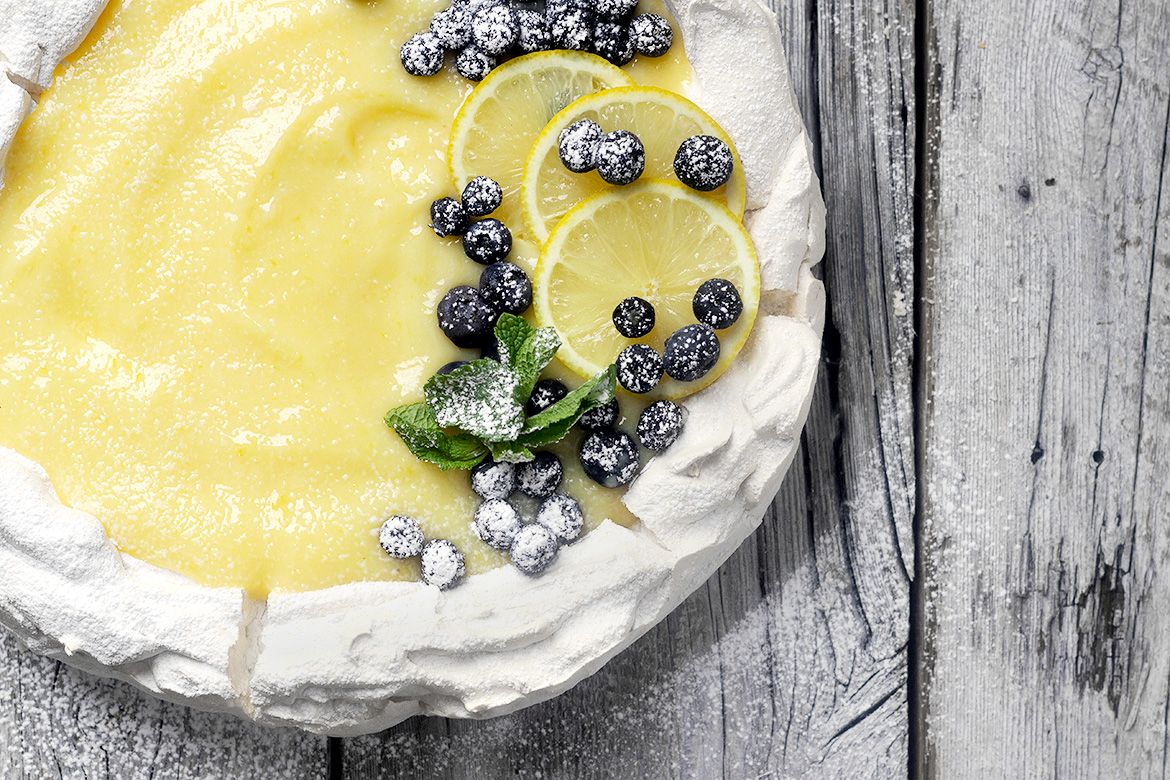
When it comes to Easter desserts, my mind always seems to go to lemon. The flavours are so bright and the pretty yellow colour of lemons is perfect for Spring. This Lemon Curd Pavlova is a great way to enjoy all those things and it’s easy to make ahead, to make your Easter cooking and entertaining easy.
A classic pavlova has a lovely light, marshmallow-like center and a crispy outside. It’s the perfect base for all kinds of things, but a creamy lemon curd is a wonderful pairing – a bit of tart with the sweet.
Recipe tips!
- As mentioned, both the pavlova meringue base and the lemon curd can be made ahead, just don’t put them together until right before serving. It only takes a minute to spread the curd on top and garnish with some lemon slices and blueberries.
- To make the pavlova ahead, simply prepare and bake off 12-24 hours ahead and leave at room temperature until needed. If you don’t need your oven, just leave it in there. Otherwise, just cover with a clean tea towel and leave it on the counter. Don’t refrigerate your meringue, as it will “sweat” and become soggy. (Note that if you are in a humid climate, you’ll need to protect it from the humidity as much as possible. An airtight container is probably your best bet here).
- The lemon curd can be made ahead and refrigerated for several days.
- The lemon curd I made for this one is not a classic curd, as it uses whole eggs instead of just the yolks. The result is a lighter, creamier curd, which is almost pudding-like. It’s a great topping for the pavlova. That said, if you have a favourite lemon curd recipe, feel free to use it instead.
- For serving, offer extra fresh blueberries for the plate. While perfect as is, a dollop of whipped cream on the side as well would never be a bad idea :)
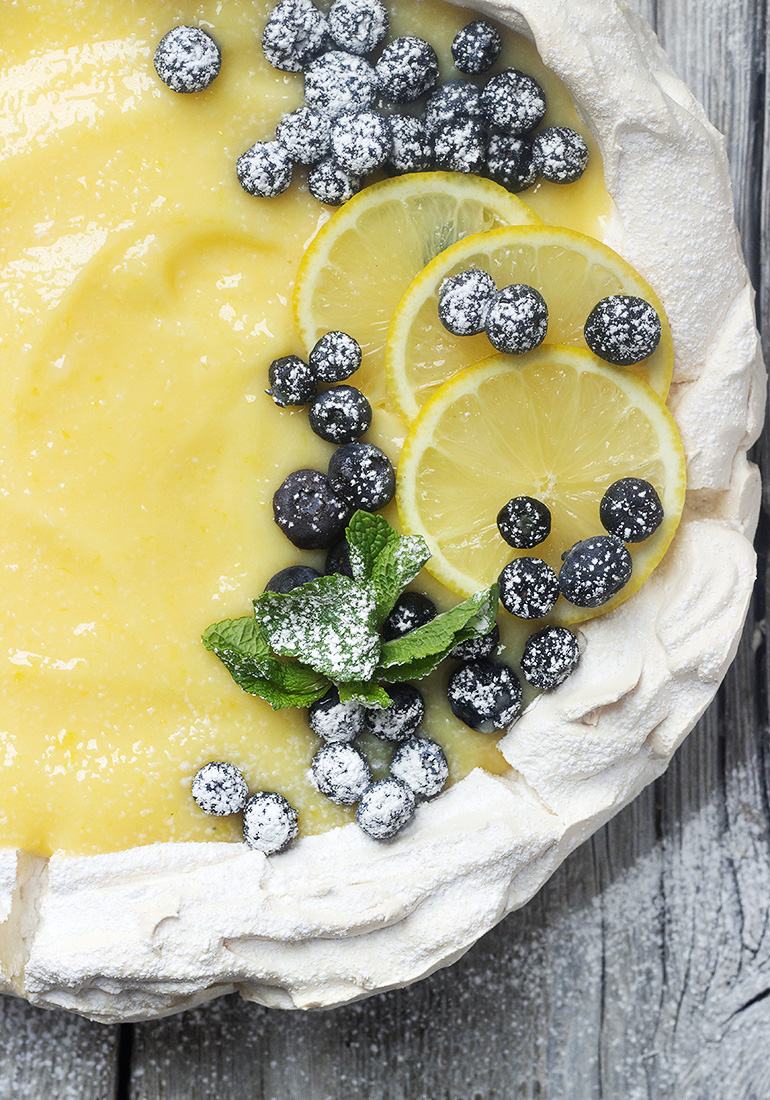
5 tips for a perfect pavlova
- Make sure your mixing bowl is squeaky clean.
- Use older eggs and separate them carefully to ensure absolute no yolk mixes with the whites.
- Separate eggs while cold, but let them sit to come to room temperature before whipping. Cold eggs separate more easily and room temperature whites will whip up better.
- Use a deep, narrow bowl to ensure that the beater are well in to the egg whites, to whip them up most efficiently.
- Whip until your sugar is fully dissolved your sugar. Using superfine sugar helps. If you only have regular sugar, you can run it through a food processor before using, to make finer grains.
Want to save this recipe?
Enter your email and I’ll send it to your inbox. Plus, you’ll get great new recipes from me every week!
By submitting this form, you consent to receive emails from Seasons and Suppers.
You can unsubscribe at any time.
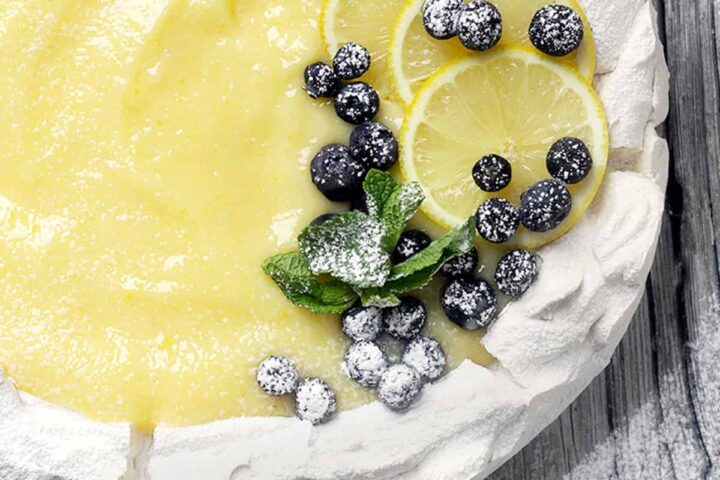
Get the Recipe: Lemon Curd Pavlova
Ingredients
Lemon Curd:
- Zest of one lemon
- 1 1/4 cup white sugar
- 1/2 cup unsalted butter, at room temperature
- 4 large eggs
- 1/2 cup freshly squeezed lemon juice, strained
- Pinch of salt
Pavlova:
- 6 egg whites
- 1 tsp cream of tartar, OR 1/2 tsp salt
- 1 1/3 cups superfine white sugar, OR normal granulated sugar run through a food processor for a minute or so or just use normal granulated sugar and beat longer per instructions
- 1 tsp vanilla extract
- 3 tsp cornstarch
- 1 tsp white vinegar
For Garnish:
- Thin lemon slices
- Fresh blueberries
- Fresh mint leaves
- Powdered sugar, for dusting
Instructions
Lemon Curd:
- Using a vegetable peeler, remove the zest of one lemon in large strips.
- In a large bowl over a pot of simmering water, combine lemon zest strips, sugar, butter, eggs, lemon juice and salt. Whisk together over the heat until the lemon curd thickens and coats the back of a spoon. This will take 15-20 minutes. Once thickened, discard lemon zest and strain through a fine mesh sieve in to a bowl. Cover with plastic wrap and refrigerate up to 1 week.
Pavlova:
- Preheat oven to 395F.
- Spray a baking sheet with cooking spray, then line with a sheet of parchment paper (the spray just helps the parchment stick to the tray, so it doesn't move around as your spreading the meringue). Place the outer ring part of an 8-inch springform pan (without the bottom part) in the centre of the baking sheet. (Alternately, draw an 8-inch circle in the centre of the parchment to use as a guide.) Set aside.
- Using an electric mixer and a clean, narrow, deep bowl or the bowl of a stand mixer fitted with the whipping attachment, beat egg whites and cream of tartar (or salt) on the highest setting until soft peaks form (using a narrow deep bowl ensures the beaters are well into the whites and will build up the greatest volume). Add sugar, 1 tablespoon at a time, without stopping the mixer, beating constantly until thick and glossy. Add 3 tsp of cornstarch with the last tablespoon of sugar. Whip mixture until sugar is completely dissolved. Dissolving the sugar should take about 10-12 mins (or if using normal granulated sugar, about 15 mins.) Test the mixture by feeling a small amount of the meringue between two fingers if it is grainy beat longer. Once the sugar is dissolved, use a rubber spatula to fold through vanilla and vinegar in a few, quick strokes.
- Spoon meringue into the springform cake ring and shape the uncooked meringue using the springform cake tin as a guide into one giant meringue. Make a slight indentation in the top, pushing the extra meringue towards the edges. You want it just slightly dished. This is where your lemon curd will go, so you want the edges higher, so it stays put in the middle. Carefully lift the springform cake pan ring straight up and remove. Place the uncooked meringue cake into the oven.
- IMMEDIATELY REDUCE OVEN TEMPERATURE TO 210F.
- Bake for 1 1/2 to 2 hours or until dry and crisp, test by tasting a teaspoon of the meringue from the top if it doesn’t taste of egg it is done don’t worry about the small hole made by this testing it will be covered by the topping. Test at 1 1/2 hours and then every 15 mins until ready. Turn off oven and leave in oven to cool completely. (pavlova may sink and crack during cooling).
- To serve: (Put curd on meringue just before serving) Spoon cooled lemon curd on top of meringue and spread evenly in the indentation, leaving the outermost edges uncovered. Arrange some lemon slices around one side. Top with a scattering of fresh blueberries and some fresh mint leaves. Dust with powdered sugar, if desired. Would also be nice with a dollop of whipped cream.
More lemon recipes to love!
Hi! I’m Jennifer, a home cook schooled by trial and error and almost 40 years of getting dinner on the table! I love to share my favourite recipes, both old and new, together with lots of tips and tricks to hopefully help make your home cooking enjoyable, stress free, rewarding and of course, delicious!


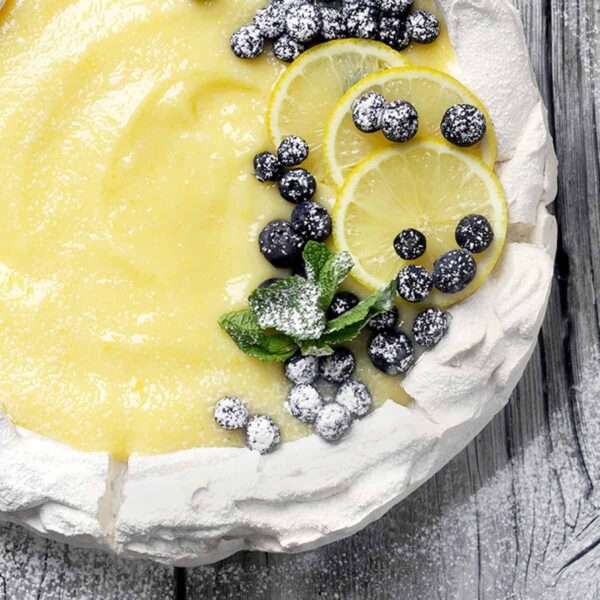
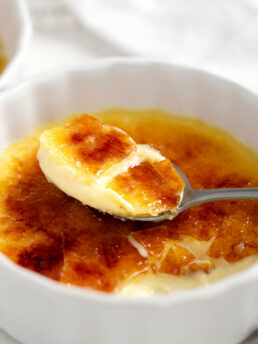
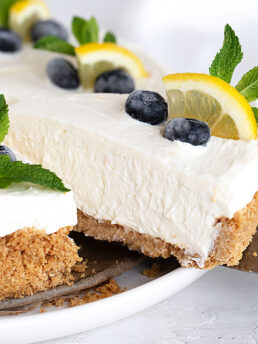
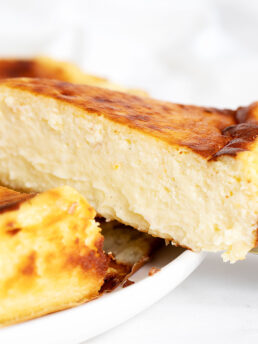

Thank you for this beautiful recipe! I have made this a few times now and it’s always a showstopper and always delicious.
Question Ive never thought of before. Could you use yolks only for the curd? Using the yolks separated from the whites? What’s your thoughts? Thank you!
Hi Vickie and so glad you are enjoying it! And yes, there are definitely lemon curd recipes that use yolks only. It will obviously be a bit richer, but if you’re looking to be most efficient with your eggs (using the egg yolks left from getting the whites for the pavlova), it would definitely be worth trying.
Thanks for the recipe! It made the most awesome pavlova/birthday cake for my Dad’s 89th birthday. It was so easy to follow your recipe, and it turned out perfectly. Sometimes it’s hard to find a celebratory dessert for someone who has celiac disease, but this worked and my dad loved it as did everyone else! Also, we took pictures to send to our favourite Kiwi, because we felt it was definitely Kiwi worthy!
So glad to hear, Kathy! Thanks so much :)
This is absolutely gorgeous and I love the lemon curd and pavlova combo!
Thanks so much, Sabrina :)
I’m new to pavlova and just finished making this for a party tomorrow. I found that the pavlova relaxed out in baking and spread in diameter. Is this a normal expectation? If it is, may I suggest adding this to the hints section? I had compared my 8” pavlova with your picture and noticed mine looked smaller when comparing the diameter to the lemons. So I spread it out some. My baked end product is now LARGE, too big for my cake plates.?
Hi Tara, pavolovas generally don’t spread. They should bake up about the same size as they were formed, if not a tiny bit smaller (shrink a bit). It could be your meringue wasn’t quite as still as it should have been.
I’m making this for a bridal shower! Yum. Beautiful. What other fruits have you used? Thank you so much for sharing!!!
Hi Susan, pavlovas are great with fresh fruit on top. Strawberries, rasperries, blueberries and or kiwi etc
Ingredients call for Cornstarch but description calls for Corn Flour. Which do I use?
Hi Meghan, corn flour is just another name for cornstarch, but confusing, for sure :) I have fixed the instructions to reflect cornstarch as in the ingredients. Thanks and enjoy!
Thank you so much for this recipe, was fabulously easy to make, and was a wonderful finish to our Easter dinner.
So glad you enjoyed it! Thanks for coming back to let me know :)
Oh, this looks so perfect! I adore pavlovas, and you’re right–lemon curd is the perfect Easter flavor.
Thanks so much, Elizabeth :)
So beautiful and the perfect Easter dessert! I love that tumble of blueberries across the top too :)
Thanks Laura!
This looks so beautiful! It screams Spring!! Do you think that coconut oil could be substituted for the butter due to a dairy allergy?
Hi Carolyn and thanks! I have to confess I have absolutely no experience substituting coconut oil for butter. My guts says you could, but that maybe use less than 1/2 cup (maybe try 1/4 cup). The butter in the curd aids in texture and smoothness, but I fear 1/2 cup of coconut oil might introduce a little too much coconut flavour. Using half is my idea of a compromise :)
So stunning. I feel like I have fallen in love! I am such a sucker for lemon curd, and Pavlova is the best friend that ‘curd’ needed. So glad you shared those tips on Pavlova. My Aussie neighbor is genius with making it, and each time I try, I am afraid I have fallen short. I am going to give it another go with this most perfect recipe. Thanks!
Thanks so much, Cindy!
I’m so not a sweets person, but this Lemon Curd Pavlova is calling my name! Lemon and spring are a perfect pairing, and I love the tart/sweet combination. Just gorgeous!
Thanks so much, Tamara :)
Pavlova is just the best dessert! My favourite topping is lots of fresh berries and lashings of whipped cream. It is often served for celebration times here in New Zealand. There is also a friendly rivalry between New Zealand and Australia as to who were the first to invent the recipe in honour of Anna Pavlova, the famous ballerina. I rest my case!! ?
As it is Easter in a few days, thankyou for the timely reminder – PAVLOVA!!
Happy Easter to you and your family. ?
Happy Easter to you as well, Mary :)
This is absolutely gorgeous!
Thanks so much :)
This is beautiful and so, so, tasty sounding! Love that curd!
Thanks so much, Katrina!
I think that’s the most beautiful pavlova I’ve ever seen! Seriously, these photos are absolutely gorgeous! I’m sure it tastes as amazing as it looks!
Thanks so much, Rachelle!